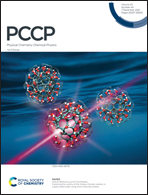Prediction of 2D ferromagnetism and monovalent europium ions in EuBr/graphene heterojunctions†
Abstract
Europium, one of the rare-earth elements, exhibits +2 and +3 valence states and has been widely used for the magnetic modification of materials. Based on density functional theory calculations, we predicted 2D EuBr/graphene heterojunctions to exhibit metallicity, huge intrinsic-ferromagnetism nearly 7.0 μB per Eu and the special monovalent Eu ions. Electron localization function (ELF), difference charge densities and Bader charge analyses demonstrated that there are cation–π interactions between the EuBr films and graphene. Graphene works as a substrate to enable the stability of EuBr monolayer crystals, where EuBr plays an important role to yield ferromagnetism and enhance metallicity in the heterojunctions. Monte Carlo simulations were used to estimate a Curie temperature of about 7 K, which, together with magnetic configurations, can be further modulated by external strains and charge-carrier doping. In general, our theoretical work predicts the properties of novel 2D ferromagnetic EuBr/graphene heterojunctions, suggesting the possibility of combining 2D intrinsic-ferromagnetic metal halide crystals and graphene, and opening up a new perspective in next-generation electronic, spintronic devices and high-performance sensors.



 Please wait while we load your content...
Please wait while we load your content...